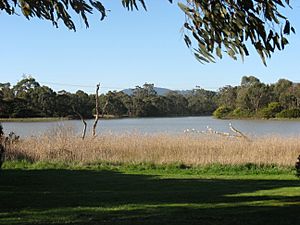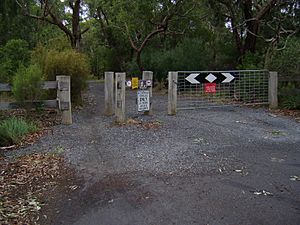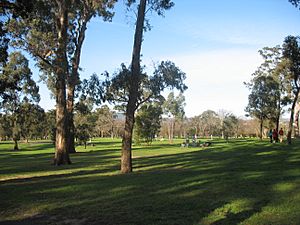Jells Park facts for kids
Quick facts for kids Jells Park |
|
|---|---|

Jells Lake, in the centre of the park
|
|
| Type | Metropolitan Park |
| Location | Wheelers Hill, Victoria, Australia |
| Area | 127 hectares |
| Created | 30 April 1976 |
| Operated by | Parks Victoria |
| Visitors | 900,000 (in 2016) |
| Status | Open all year |
| Paths | Conservation Trail, Dandenong Creek Trail, Scotchmans Creek Trail, EastLink Trail |
| Habitats | Swampy woodland, swampy riparian woodland |
Jells Park is a large public park located in Wheelers Hill. This suburb is in south-east Melbourne, Victoria, Australia. The park first opened on 30 April 1976. It is named after Joseph Jell, who used to graze cattle in the area a long time ago.
Many people visit Jells Park each year, with over 900,000 visitors in 2016. The park covers about 127 hectares, which is like 250 football fields! It has 9 kilometres of paths perfect for cycling and walking. These paths connect to other trails like the Scotchmans Creek Trail, EastLink Trail, and Dandenong Creek Trail. The Dandenong Creek Trail also links up with the Blind Creek Trail.
Nature and Animals
Even though parts of Jells Park have been changed and replanted, it is still home to many different plants and animals. It is an important part of the Dandenong Creek area, which acts like a natural highway for wildlife. The park mainly has two types of natural areas: swampy woodland and swampy riparian woodland.
The park features a human-made lake called Jells Lake. There are two jetties where people enjoy fishing. However, a type of fish called European carp are found in large numbers in the lake. They can cause problems for the other plants and animals living there.
Next to the lake, there is a grassy area for picnics. The rest of the lake is surrounded by natural bushland. In this bush, you can find a bird hide. This is a special spot where you can quietly watch many native birds. You might see Australasian swamphens, pelicans, Eurasian coots, dusky moorhens, and different kinds of ducks.
Paths and Trails
Jells Park has a big network of paths that everyone can use. These paths are great for cycling, walking, and running. The Dandenong Creek Trail goes through the park from north to south. The Scotchmans Creek Trail also runs through the park from the west. It connects with the Dandenong Creek Trail in the south-east corner. The EastLink Trail runs along the southern edge of the park. A bit north of the park, the Blind Creek Trail comes from the east and also ends at the Dandenong Creek Trail.
The Conservation Trail follows the eastern side of Jells Lake. Along this path, you will pass by small ponds called billabongs and other wet areas. The bird hide, where you can watch birds, is also found along this trail.
Most of the paths in the park are paved, making them smooth for walking or riding. Some paths are made of firm gravel. The paths usually have good signs, so it's easy to find your way around. They are also suitable for prams. You can bring your dog to most parts of the park, but they must be on a leash. Dogs are not allowed in the natural bushland areas.
Fun Things to Do
Jells Park is a popular spot for picnics and barbecues. There are also playgrounds at Yabby Hill for kids to enjoy. In late 2018, the park updated its barbecues. They removed the old wood-burning ones and replaced them with eight newer gas barbecues.
The park has several picnic areas:
- Pines Picnic Area: Has picnic shelters, barbecues, and car parking. There are toilets and a playground here.
- Stringybark Picnic Area: Offers picnic shelters, barbecues, and car parking.
- Elms Picnic Area: This is a large grassy area.
- Jells East Picnic Area: Has car parking and toilets, with good access for people with disabilities.
- Oaks Picnic Area: Features picnic shelters, barbecues, car parking, and toilets. It also has a playground and is accessible for people with disabilities.
- Ashes Picnic Area: Provides picnic shelters, barbecues, and car parking. It is accessible for people with disabilities and has information available.
There is a visitor centre in the north-west part of the park. It is run by Parks Victoria and includes a cafe and public toilets.
In the southern part of the park, there are two large ovals. These are often used for sports. When they are not being used for games, everyone is welcome to use them.



